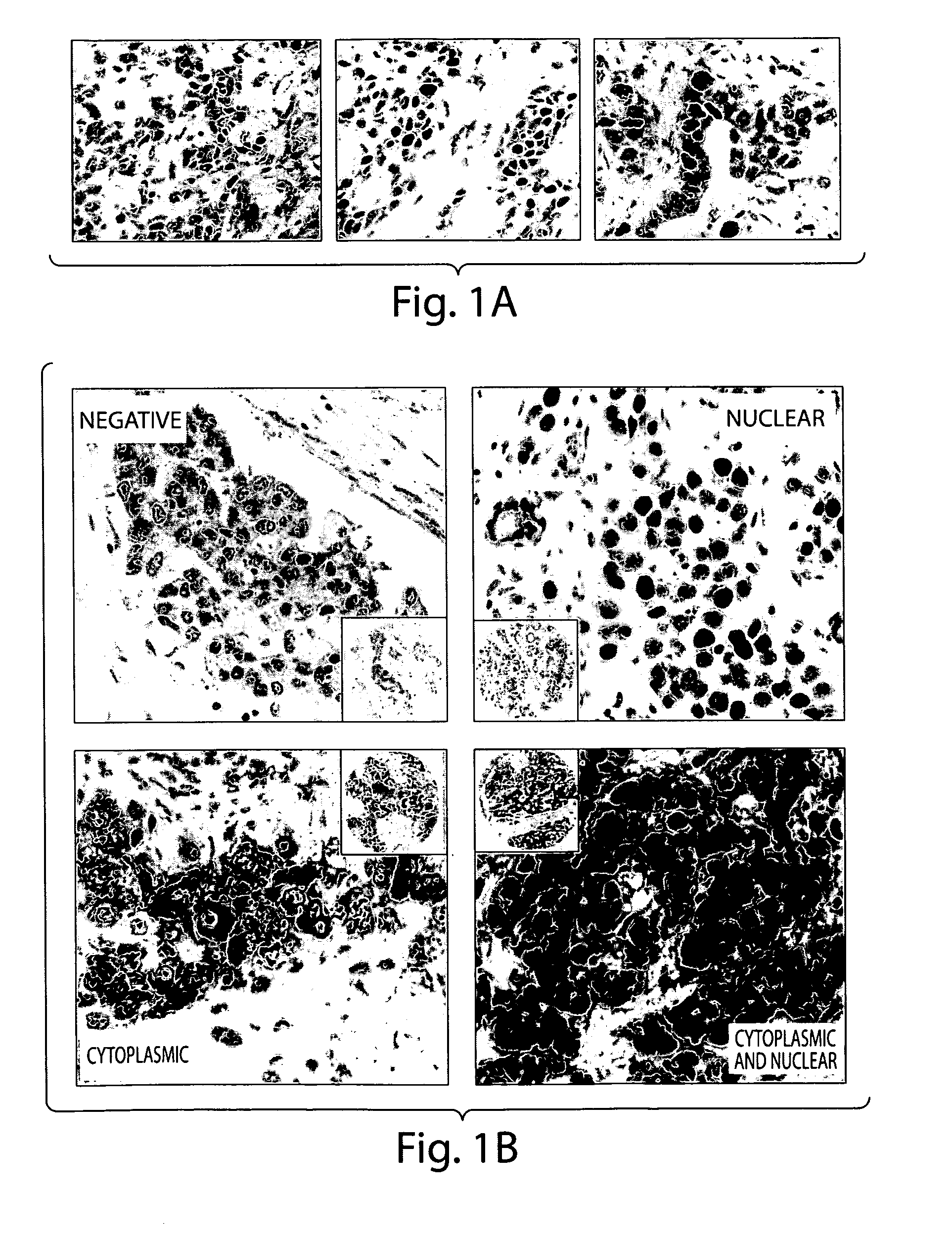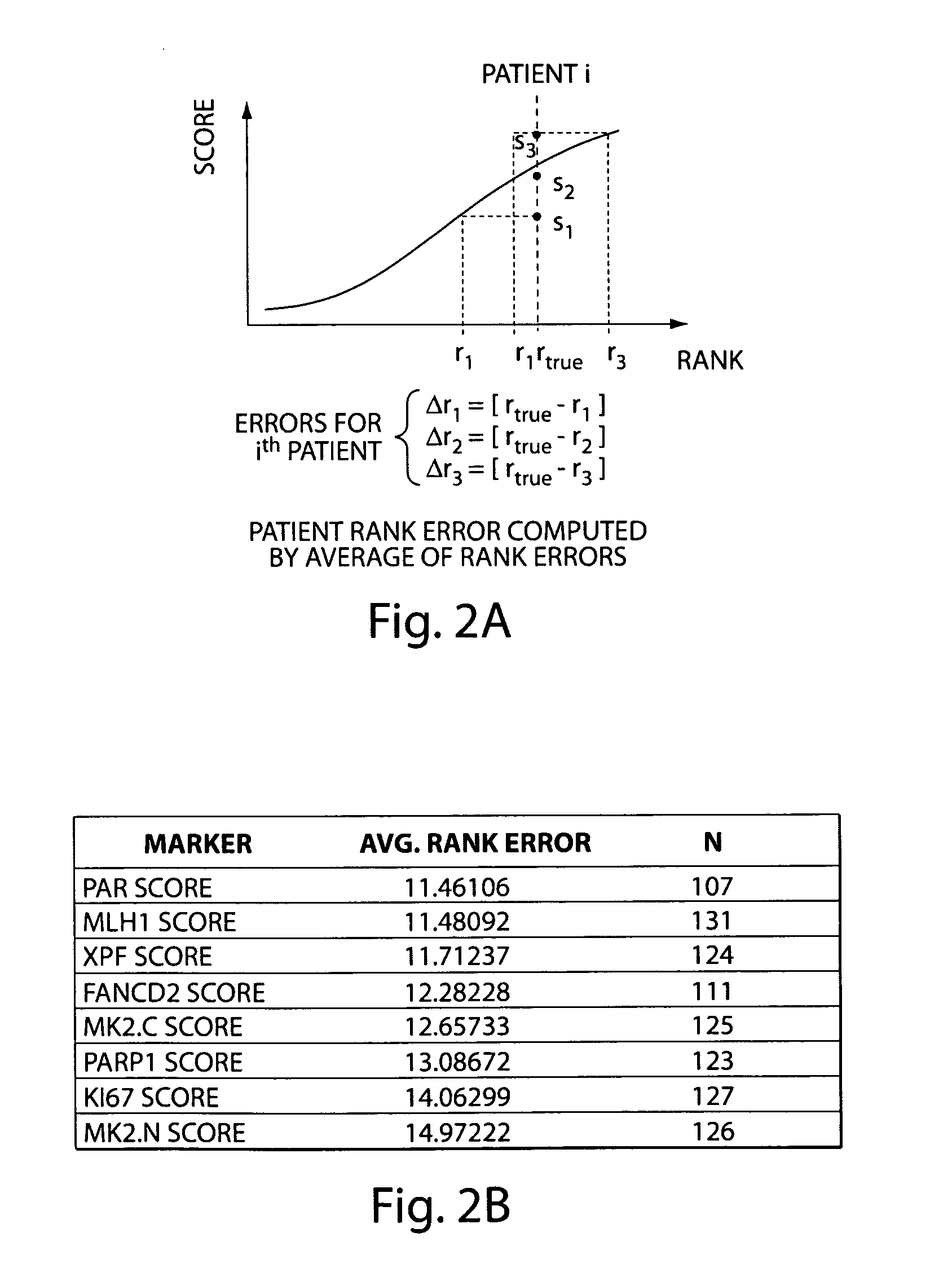DNA Repair Proteins Associated With Triple Negative Breast Cancers and Methods of Use Thereof
a technology breast cancer, applied in the field of dna repair proteins associated with triple negative breast cancer, can solve the problems of relative lack of biomarker information available for patient stratification and direct treatment decisions
- Summary
- Abstract
- Description
- Claims
- Application Information
AI Technical Summary
Benefits of technology
Problems solved by technology
Method used
Image
Examples
example 1
General Methods
[0146]Patient Cohort
[0147]One hundred and forty three previously treated women with triple negative breast cancers were identified and used their archived, formalin-fixed, paraffin-embedded primary excision biopsies to create a tissue microarray (TMA). The majority of these patients were treated with anthracycline-based chemotherapy in the adjuvant setting.
[0148]Antibody IHC
[0149]The TMA was stained using antibodies against proteins in DNA repair pathways including XPF (nucleotide excision repair), FANCD2 (Fanconi Anemia pathway), MLH1 (mismatch repair), PARP1 (base excision repair), PAR (base excision repair), pMK2 (MapkapKinase2, DNA damage response), P53, and Ki67. The antibodies were obtained from the following sources: XPF (AbCam), FANCD2 and p53 (Santa Cruz), MLH1 and Ki67 (BioCare Medical), PARP1 (AbD Serotec), PAR (poly-ADP ribose, Millipore), phosphoMapkapKinase2 (Cell Signaling Technology). IHC runs were conducted with negative and positive human breast canc...
example 2
DNA Repair Protein Change is Frequently Observed in Triple Negative Breast Cancer
[0154]Breast cancer patients that were diagnosed to have the Triple Negative breast cancer subtype by absence of Her2, ER, and PR by standard histopathology criteria were organized into a study group. The patient biopsies had been obtained from a primary excision biopsy and the patients received chemotherapy according to the approved protocols at the Dana-Farber Cancer Institute. A Tissue Microarray (TMA) containing three 600 m2 core regions of cancer tissue per patient was constructed in order to efficiently evaluate the markers, and to minimize the effects of staining variation between patient specimens in immunohistochemistry. The goal of the study was to develop a biomarker pattern at the biopsy stage that would inform how aggressively a patient's tumor would return under standard therapy.
[0155]DNA repair pathways are important to the cellular response network to chemotherapy and radiation. In this ...
example 3
Association of DNA Repair with Recurrence of Cancer in Chemotherapy-Treated Triple Negative Breast Cancer Patients
[0157]Clinical data for 115 patients with primary treatment data was available with a median follow up of 58 months. Median age for the cohort was 49.3 years. Sixty-eight patients were treated with breast conserving therapy and 47 were treated with mastectomy, 17 of which received post mastectomy radiation. One hundred ten patients received chemotherapy as part of their treatment: 42 with anthracycline / cyclophosphamide, 50 with anthracycline / cyclophosphamide / taxane, 15 with cyclophosphamide / methotrexate / 5-FU based regimens and 3 other regimens. Eighteen patients had BRCA1 mutations and 5 had unknown variants. There were 37 recurrences: 18 were distant first, 12 were local first and 7 were simultaneous.
[0158]Eleven biomarkers were analyzed for their ability to predict the likelihood of disease recurrence. Rach TNBCMARKER was then evaluated for the separation between betwe...
PUM
| Property | Measurement | Unit |
|---|---|---|
| time | aaaaa | aaaaa |
| time | aaaaa | aaaaa |
| time | aaaaa | aaaaa |
Abstract
Description
Claims
Application Information
 Login to View More
Login to View More - R&D
- Intellectual Property
- Life Sciences
- Materials
- Tech Scout
- Unparalleled Data Quality
- Higher Quality Content
- 60% Fewer Hallucinations
Browse by: Latest US Patents, China's latest patents, Technical Efficacy Thesaurus, Application Domain, Technology Topic, Popular Technical Reports.
© 2025 PatSnap. All rights reserved.Legal|Privacy policy|Modern Slavery Act Transparency Statement|Sitemap|About US| Contact US: help@patsnap.com



